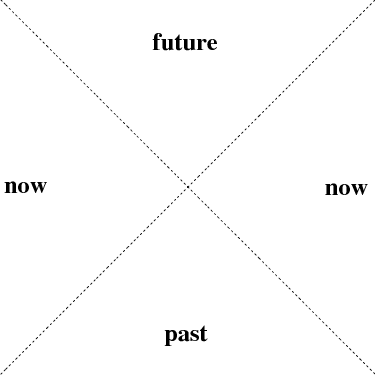- §1. The Surveyors
- §2. Spacetime Diagrams
- §3. Lorentz Transformations
- §4. Space and Time
- §5. Dot Product
Space and Time
We now return to the peculiar fact that the “squared distance” between two points can be positive, negative, or zero. This sign is positive for horizontal distances and negative for vertical distances. But these directions correspond to the coordinates $x$ and $t$, and measure space and time, respectively — as seen by the given observer. But any observer's space axis must intersect the hyperbola $x^2-\csq t^2=\rho^2$ somewhere, and hence corresponds to positive “squared distance”. Such directions have more space than time, and will be called spacelike. Similarly, any observer's time axis intersects the hyperbola $x^2-\csq t^2=-\rho^2$, corresponding to negative “squared distance”; such directions are timelike.
What about diagonal lines at a (Euclidean!) angle of $45^\circ$? These correspond to a “squared distance” of zero — and to moving at the speed of light. All observers agree about these directions, which will be called lightlike. In hyperbola geometry, there are thus preferred directions of “length zero”. Indeed, this is the geometric realization of the idea that the speed of light is the same for all observers!
It is important to realize that every spacelike direction corresponds to the space axis for some observer. Events separated by a spacelike line occur at the same time for that observer — and the (square root of the) “squared distance” is just the distance between the events as seen by that observer. Similarly, events separated by a timelike line occur at the same place for some observer, and the (square root of the absolute value of the) “squared distance” is just the time which elapses between the events as seen by that observer.
On the other hand, events separated by a timelike line do not occur simultaneously for any observer! We can thus divide the spacetime diagram into causal regions as follows: Those points connected to the origin by spacelike lines occur “now” for some observer, whereas those points connected to the origin by timelike lines occur unambiguously in the future or the past. This is shown in Figure 5.3. 1)
In order to be able to make sense of cause and effect, only events in our past can influence us, and we can only influence events in our future. Put differently, if information could travel faster than the speed of light, then different observers would no longer be able to agree on cause and effect.
 Figure 5.3: The causal relationship between points in spacetime and the origin.
Figure 5.3: The causal relationship between points in spacetime and the origin.